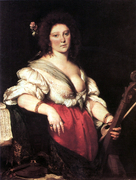Barbara Strozzi: A Woman Composer in 17th-Century Venice
Vivian Tompkins
Monday, July 3, 2017

The following was written by Vivian Tompkins, our intern at the Central Office in Frankfurt in summer 2017:
2017 is an important anniversary for Venice. This year the city celebrates the life and works of Claudio Monteverdi (1567-1643), who was born 450 years ago. While Monteverdi is certainly the best known composer who was active in Venice during the seventeenth century, the “Floating City” was also home to many other musicians whose works and performances shaped the central genres of the Baroque. One of these musicians was the composer and singer Barbara Strozzi (1619-1677).
The only surviving portrait of Strozzi (see image) shows us a woman who is clearly musically talented. She holds a viola da gamba and is standing next to a violin and what appears to be a collection of songs. This portrait was painted by Bernardo Strozzi (c. 1581-1644; no relation), probably during the same period in which he created his famous portrait of Monteverdi (which dates from around 1630). Barbara Strozzi’s musical career, however, was very different from that of Monteverdi. Indeed, Strozzi’s performances and compositions were unique in many ways. Women musicians in seventeenth-century Venetian society could typically have either a fully public career (as an opera singer) or a fully private career (as a courtesan), yet Strozzi’s music was both public and private. The adopted daughter of the author and librettist Giulio Strozzi, whose texts were set by Monteverdi, Barbara Strozzi had unique musical opportunities and relationships. She studied composition with the great opera composer Francesco Cavalli and was even able to publish her works. Yet Strozzi never appeared on the stage of any of the Venetian theaters. Instead, her performances took place in her father’s private intellectual academy, the Accademia degli Unisoni. The men of this academy were probably the only audience that witnessed her performances.
Although Strozzi’s performances took place in a private sphere, her music was certainly known outside of this sphere, since she published eight volumes of her compositions. Most of these works belong to a single genre: the chamber cantata. Since Strozzi herself likely sang and played these compositions, the majority of them are set for soprano and basso continuo. Many of the texts of these works deal with the suffering caused by love, a central theme in the debates of the Accademia degli Unisoni. In order to emphasize this theme musically, Strozzi created frequent and sudden contrasts between recitative-like and arioso sections in her cantatas. While the majority of her oeuvre consists of chamber cantatas, Strozzi also composed madrigals, short arias, and motets.
All of Strozzi’s published collections can be found in the RISM online catalog; unfortunately, one volume of her compositions (op. 4) is lost. Also listed in the RISM catalog are copies of Strozzi’s arias and other vocal works. The list of libraries in which these sources are located is relatively long and diverse: the British Library (RISM library siglum GB-Lbl, 3 sources), the Wrocław University Library (PL-WRu, 1 source), the International Museum and Library of Music of Bologna (I-Bc, 3 sources), and the State Library of Berlin (D-B, 2 sources) are only a few examples. Some of Strozzi’s works—specifically her op. 1, op. 6, and op. 7—are also accessible in digitized form. Click on the links above to get a closer look at her published volumes.
Image: Bernardo Strozzi, Eine Gambenspielerin, ca. 1630-1640, Gemäldegalerie Alte Meister (Dresden), via Wikimedia Commons.
Share Tweet EmailCategory: New at RISM

